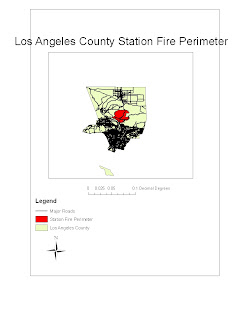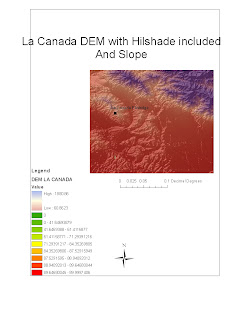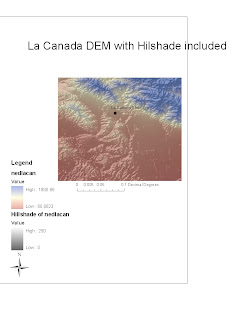Scientifically speaking, mudslides are when high levels of debris, such as rocks, water, and tree branches, flow at high velocities with the potential of causing harm to both roadways and buildings. Clearly, the after effects of a massive fire leads to the build up of such debris in excessive amounts. Another major contributor to the mudslide problem cause from the Slope in the region of question. The greater the slope of the region, the greater the gravitational pull on the debris leading to a faster flow of debris. The region of La Canada borders the San Gabriel mountains. As seen in the map, this region features substantial slopes which will certainly have an effect once a heavy downpour of rain enters Los Angeles County.
As seen in my contrasting images of the La Canada region, the slopes are extraordinarly large in this region. The San Gabriel mountains cause such a high degrees in terms of slope in these regions. I included the hillshade effect to demonstrate again the mountainous terrain on the La Canada region. These factors contribute to what will be a dangerous rainy season ahead for the residents of La Canada.
These residents have had to prepare for the effects of the mudslide imediately after overcoming the pain set in by the Station Fire. It is projected that the effects of the Station Fire will continue in the La Canada region for up to 5 more years. The unfortunate geography of the region of La Canada leads to much more potential damage.
I chose to make my project regarding the mudslide damage potential because, as we have just learned about DEM and Slope analysis, I felt very comfortable in presenting information to demonstrate the effects of the Station Fire. Once again, GIS is able to present an image with the written words that can aid any audience in understanding the effects of the Station Fires.



Works Cited
Knoll, Corina and Zavis, Alexandra. "After the Station fire, a new danger: mudslides" Los Angeles Times 9-17-2009
Seib, Al. "Mudslide damages six homes, closes roads in La Canada, Flintridge" Los Angeles Times. 11-13-2009
Shaffer, Jen. "The Science of Slides: A Primer on How Debris Flow Works" Lodging and Landslides: A clear cut Controversy. Wildfirenews.com (Accessed 11-23-2009).
"La Canada, Flintride" Wikipedia.com (Accessed 11-23-2009) [http://en.wikipedia.org/wiki/La_Ca%C3%B1ada_Flintridge,_California]
National Map Seamless Server (Acessed 11-23-2009) [http://seamless.usgs.gov/website/seamless/viewer.htm]
Los Angeles County Enterprise GIS (Accessed 11-23-2009) [http://gis.lacounty.gov/eGIS/?s=station+fire]







